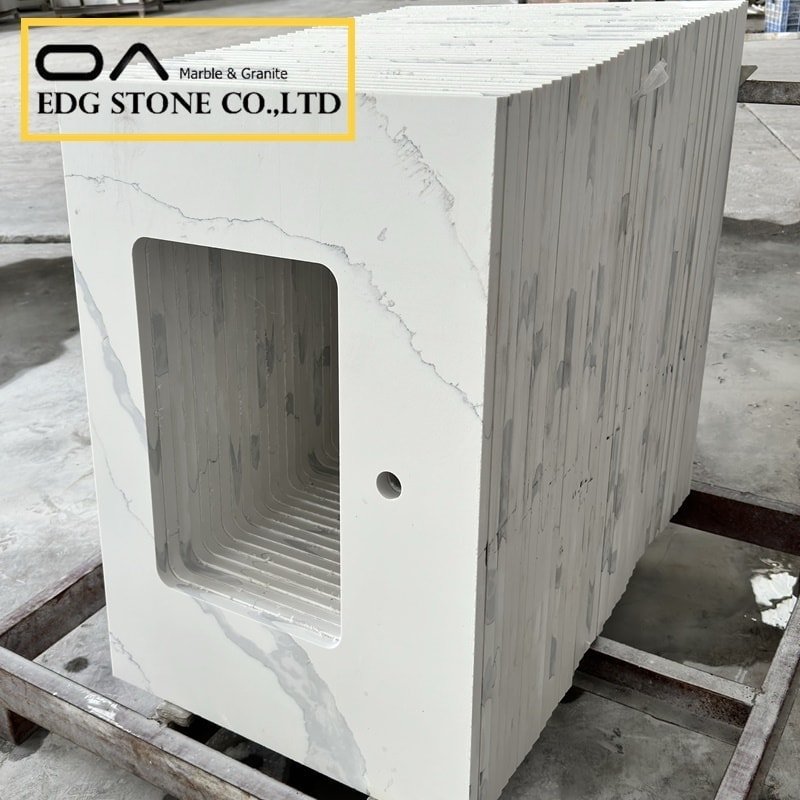To produce high-quality, customer-satisfied countertop products, as long as you follow the production process, reasonable plans, arrangements, implementation, and follow-up checks, you can enter the normal production track.
First of all, the process flow must be clear: material selection→discharging→feeding (circular saw)→saw cutting→inspection→infrared bridge cutting→table panel processing workshop→bonding (bottlenose edge, duck mouth edge, flat edge, etc.)→up Machine processing special-shaped edges (duck beak edge, cow nose edge, etc.) → dig basin holes, drill holes → sanding → inspection → protection → packaging → delivery.
Material selection and discharging: According to the agreement board (sample) provided by the customer, compare the agreement board with the raw material blocks, and knock a piece of it and polish it with a small hand grinder to check whether the color, pattern, and particles are consistent. Pay attention to the material selection link. If there is a problem in this link, all subsequent processes will be suspended for materials. The quality of blocks shall be inspected by water spraying method and visual inspection method, and the same mining area, the same color, pattern, grain, and density must be selected; from the appearance, no cracks, stone gall, color lines, sweeping flowers, etc. are allowed For similar impurities, the quantity of the production order will be used for reasonable discharge.
Sawing and unloading: the blocks are sawed on a circular saw, and the sawing process is carried out according to the drawings and discharge requirements, and then the sawn rough board is checked and accepted, the unqualified products are removed, and the qualified products are placed on the iron frame to be transferred Into the next process; put the product whose thickness exceeds the standard on another iron frame, and wait to be transferred to the next process to determine the thickness.
Coarse grinding: rough grinding of fixed thickness products and qualified products. After the rough grinding is dried, the surface of the product is brushed. After brushing, the pores, micro holes, chicken feet, etc. on the surface of the product can be filled, making the product surface beautiful, Smooth, bright colors, improved gloss.
Polishing: After polishing the qualified products one by one, mark the cracks, light colors, stone gall, and sweeping patterns on the board with a red crayon, so that the next process can be found in time, and the cracks and stone gall It can be processed into products of small specifications, such as water baffles, etc., and the stone color and sweeping flowers can be removed; the gloss of the product is required to be above 90°; the flatness of the product is controlled.
Infrared bridge cutting machine: discharging and cutting qualified products according to the production order to ensure that the geometric dimensions, angular dimensions, and diagonal dimensions of the products are accurate; no chipping or corner drop is allowed; especially the back of the countertop needs to be bonded It is necessary to keep the edges, edges and corners intact; no yin and yang sides are allowed on the board. Cracks, dark spots, alkalis, sweeping flowers, etc. are not allowed.
Countertop processing: When bonding, use a small hand cutter to smooth the bonding part of the product and then process the bonding surface into a rough surface to bond the product more firmly. The bonding seam between the product and the product should be as small as possible (0.1 ~0.2mm), after bonding and drying, machine the special-shaped edges (bottlenose edge, duck mouth edge, etc.), which need to be processed by hand for the opening, drilling, and cutting irregular shapes.
Polishing: Polishing is the first process of polishing. The product must be polished according to the modeling surface to keep the shape of the modeling surface consistent with the drawing. If the polishing is not in place, no amount of time will be required for the subsequent polishing to achieve the desired effect. Therefore, the polished product should be flat, smooth, without obvious hand feeling and wavy lines.
Small hand grinder polishing: Use a small hand grinder to polish the product. The gloss is required to be above 90°. After polishing, the surface becomes a mirror gloss without bumps or waves; the straightness of the junction is maintained in a straight line, and the gloss The degree is consistent.
Edge polishing: For many products, the edges are only 20-30mm, and the entire edge needs to be polished. However, it is difficult to polish the glass with a small hand grinder, and the processing speed is slow. Therefore, the products that need to be edged are fixed into a hole with a fixed jig and polished with a large grinder, which not only improves the gloss, but also has good flatness, and there is no wave pattern and hand feeling.
Finished product: inspect the product piece by piece, and replace the unqualified product in time; if the surface of the board is not polished in place, make-up treatment is required. If it is a black product (Shanxi black), the color of the polished part will return to white after bonding, which will affect the appearance of the product. After marking it with a marker pen (black), the color of the marker pen will penetrate into the product and make This place is consistent with the color of the product, reflecting the overall beauty of the product. The above method can also be used for products of other colors. But the glue color must be consistent with the product color. It is better to not see the glue repair position when standing up.
Protection and packaging: The product will be waterproofed according to the customer’s requirements; the product will be packaged according to export standards, and no bark or insect eyes are allowed in the wood board. The product should be marked with “do not press”, “up” and other signs.







